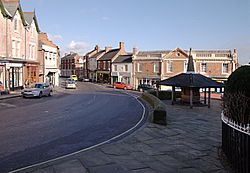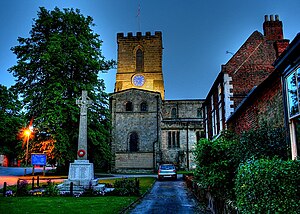Melbourne, Derbyshire
| Melbourne | |
| Derbyshire | |
|---|---|
 The Market Place | |
| Location | |
| Grid reference: | SK385255 |
| Location: | 52°49’23"N, 1°25’44"W |
| Data | |
| Population: | 4,843 (2011) |
| Post town: | Derby |
| Postcode: | DE73 |
| Dialling code: | 01332 |
| Local Government | |
| Council: | South Derbyshire |
| Parliamentary constituency: |
South Derbyshire |
Melbourne is a town and parish in southern Derbyshire, about eight miles south of Derby, eight miles north of Swadlincote and two miles from the River Trent. The population of the civil parish (including Kings Newton) at the 2011 Census was 4,843.[1] In 1837 a then tiny settlement in Australia was named after William Lamb, 2nd Viscount Melbourne, Queen Victoria's first Prime Minister, and thus indirectly takes its name from the village.
History
The name Melbourne means "mill stream" i.e. the mill by the stream. It was first recorded in Domesday Book (DB 1086 Mileburne = mill stream) as a royal manor.
A parish church was built around 1120.
In 1311 Robert de Holand fortified the existing royal manor house to create Melbourne Castle, though the fortification was never completed. John I, Duke of Bourbon, the most important French prisoner taken at the Battle of Agincourt (1415), was detained at the castle for 19 years.
Mary, Queen of Scots was to be imprisoned at Melbourne Castle, but it had deteriorated into a poor state of repair. By the early 17th century it had fallen into decay and was demolished, although some remains can still be seen.[2]
Melbourne Hall was originally owned by the church; it was constructed in stages, mainly in the 17th and 18th centuries.
During the Second World War a military training railway was operated to the north of the now defunct Melbourne railway station.
Since 2005 Melbourne has run an arts festival every September.[3]
Notable residents
- Edward Martin, photographer 1881-1917
- Robert Bakewell, ironsmith, started his career here in 1706.
- John Joseph Briggs, naturalist lived in Kings Newton and published a History of Melbourne.[4]
- Thomas Cook, travel agent, was born here in 1808.
- William Dexter, painter was born here in 1808.[5]
- Viscount Melbourne, British prime minister, 1834 and 1835-1841.
- Rowland Ordish, civil engineer was born here in 1824.
- John Young, cricketer was born here in 1876.[6]
- Ronald Pope, sculptor and artist
- Andrew Cope, children's author
Places of interest

Melbourne parish church has been described as a "cathedral in miniature" and is one of five churches in Melbourne. The Domesday Book records a church and priest here in 1086. The present church was built about 1120, and most of the original masonry is intact, except for the eastern end which has been refurbished. The roofs, naves, aisles and the aisle windows date from the restoration of the 1630s. There was also a restoration done by Gilbert Scott in 1859-62.[7]
Melbourne Hall was originally the rectory house for the Bishop of Carlisle, but was substantially rebuilt by Thomas and George Coke in the early 18th century. The hall's gardens were laid out with the assistance of royal gardeners in 1704. They contain examples of the work of Derby ironsmith Robert Bakewell. Melbourne Pool was originally used by the nearby mill. The hall is open to the public in August.
The Thomas Cook Memorial Cottages in High Street were built by Thomas Cook who started popular travel in Britain. Cook was born in Melbourne in 1808 though his birthplace was demolished in 1968. The buildings built in 1890-91 include fourteen cottages, a bakehouse, a laundry and mission hall. They still provide accommodation for some of Melbourne's senior citizens.
Melbourne Market Place is the location of Melbourne's main shops, including the Co-op building and monument which was refurbished in 1998.
Sport
The town plays host to Melbourne Rugby Football Club,[8] Melbourne United Football Club,[9] Melbourne Town Cricket Club.[10] and Melbourne Royal British Legion Tug of War Club, Melbourne Bowls Club. There is also a popular, free entry recreation ground, which holds MTCC, MRFC and MUFC fixtures on a regular basis. There is also a modern sports pavilion, designed by Heath Avery Architects,[11] which will contain changing rooms and toilets, and a desk where people interested in booking out the newly developed astro-turf pitches can book.
Culture, industry and transport
The town contains many Georgian buildings and in the 19th century was a centre for framework knitting and footwear manufacture, e.g. Fairystep Shoes. Market gardens have always been a major part of the economy, though now only a handful remain. East Midlands Airport, five miles to the east of the town, was opened in the 1960s and has now become a significant regional transport hub.
There is a wide range of shops and services including a Sainsburys supermarket
Services in Melbourne include: A bank, a post office, a pharmacy, a library, the Melbourne Assembly Rooms (formerly the Bill Shone Leisure Centre) and a youth club. There are also several pubs and restaurants.
In March 2013 Melbourne was ranked as the 15th best town in Britain to live in by The Times newspaper, Melbourne Festival was also named as one of the Top 10 British Craft Events by Country Living. In April 2013 Melbourne became the first town in Derbyshire to receive Walkers are Welcome Town status.
References
- ↑ "Civil Parish population 2011". Neighbourhood Statistics. Office for National Statistics. http://www.neighbourhood.statistics.gov.uk/dissemination/LeadKeyFigures.do?a=7&b=11126453&c=Melbourne&d=16&e=62&g=6414890&i=1001x1003x1032x1004&m=0&r=1&s=1459076888672&enc=1. Retrieved 27 March 2016.
- ↑ "Melbourne Castle". Castleuk.net. http://www.castleuk.net/castle_lists_midlands/128/melbournecastle.htm.
- ↑ Melbourne Arts. "Melbourne Festival". Melbourne Festival. http://www.melbournefestival.co.uk/index.html.
- ↑ Briggs in Dictionary of National Biography 1866
- ↑ "Serle, Percival (1949). "Dexter, William". Dictionary of Australian Biography. Sydney: Angus and Robertson". Gutenberg.net.au. http://gutenberg.net.au/dictbiog/0-dict-biogD.html#dexter1.
- ↑ John Young at Cricket Archive
- ↑ "Melbourne Parish Church Website". Melbourneparishchurch.co.uk. 13 November 2011. http://www.melbourneparishchurch.co.uk/.
- ↑ "Melbourne RFC website". Melbourne-rfc.com. 9 August 2012. http://www.melbourne-rfc.com/.
- ↑ "Melbourne United website". Melbourneunited.org.uk. 11 September 2011. http://www.melbourneunited.org.uk/.
- ↑ "Melbourne Town CC website". Melbourne.play-cricket.com. http://melbourne.play-cricket.com/home/home.asp.
- ↑ "Heath Avery Architects in Cheltenham, Gloucestershire". http://www.heath-avery.co.uk/. Retrieved 2016-03-12.
Outside links
| ("Wikimedia Commons" has material about Derbyshire Melbourne, Derbyshire) |
